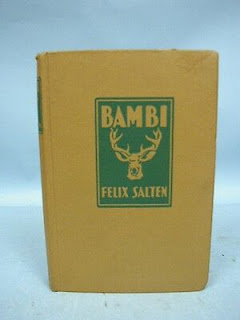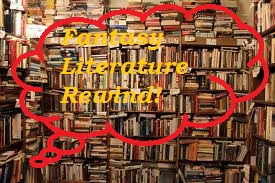Hooray! It's Public Domain Day! Or at least close enough to it! Lately, every New Year's Day has been a big deal for not just college football fans but also English majors, art lovers, movie buffs and people who just like intellectual property law to be used fairly. Because of the Sonny Bono Copyright Term Extension Act of 1998 (which was largely concocted to protect the rights of Disney's cartoon “Steamboat Willie”), nothing had entered the public domain in the United States in years. But since January 1, 2021, things had started to once again become free to use and inspire further creativity without the need to pay pricey licensing fees.
So, today we're going to welcome a classic to the public domain: Bambi: A Life in the Woods by Felix Salten!
 |
| The cover of my current version of the book. |
Uh . . . what's that? You thought I was going to say Winnie-the-Pooh? Well, Milne's first Pooh book is entering the public domain and the media and people online are making a bigger deal out of it. But the thing is, I already did a Pooh spotlight.
Anyway . . .
Uh, yes . . . you thought Bambi already came into the public domain last year (or was it the year before? ). Well, the thing is that due to English language version of the book being copyrighted later in the United States than the German version was in Europe, it actually has a later public domain debut over here in the U.S.
Guys, I really can't keep stopping to answer questions.
Anyway, first a little about the author. Felix Salten was born in Pest, Austria-Hungary on September 6, 1869 as Siegmund Salzmann. He was the grandson of an Orthodox rabbi. About a month after he was born, his family relocated to Vienna, Austria as many Jewish families did at the time after the Imperial government granted full citizenship rights to Jews in 1867. Salten went to work at 16 after his father went bankrupt, but also started submitting poems and book reviews to journals and became part of the Young Vienna movement. He then went on to be a full-time art and theater critic and started Vienna's first, short-lived literary cabaret. At the height of his productivity he averaged about one book a year and wrote for pretty much all the major newspapers in Vienna, as well as writing film scripts and librettos. His books were briefly banned in Austria, but for the most simple and obvious reasons (he was Jewish and Austria had been taken over by Nazis). Salten ended up moving to Zurich, Switzerland and spent his final years there, dying in 1945.
The most popular of his works, though, is Bambi (or Bambi: A Life in the Woods if you're in a mood for lengthy titles). It was a big hit when it came out. The English translation that came out in 1928 by Siegel and Shuster ended up being a Book-of-the-Month club success. It was also novel because it was one of the first “environmental novels”, which looked at nature and was critical of humanity's impact on it. The irony is actually that most of the criticism and the antagonistic role in general is laid on a human hunter and Salten himself was an avid hunter.
 |
| First edition cover of Bambi |
The story follows the life of Bambi, a young roe deer, from his birth to when he comes of age. The story deals with the changing of the seasons and the hardships and joys of his life, like his meeting with his childhood friends Faline and Gobo, his interactions with other forest animals like the hare and the owl, his brief but meaningful interactions with his father the great “Prince” who watches over everything, the struggles to find food in the winter, his reunion with Faline as a young adult and his rivalry with other male deer named Karus and Ronno. This book is actually a bit hard to describe because it's meant to be a life story. The plot is basically just “Bambi grows up”. But there is one driving antagonist that does hang over the entire thing: HIM! Or, as you probably know him from the Disney adaptation: MAN. The animals of the forest do not seem to have a word for Humanity. Humanity is always referred to as “He” or “Him” (note, I will be completely capitalizing these words going forward when referencing humanity's actions in the book for clarity's sake. Also, for dramatic effect). This is actually a very effective way of advertising what a strange and ominous force humanity is in the forest. Humankind is spoken of as if it's some mysterious, confounding and ultimate dangerous force. Some strange mix of god, demon, otherworldly invader and all-around boogeyman. And the things he does are strange and insidious. We all know that HE killed Bambi's mother. In the course of the book he also nearly gets Bambi killed by using a deer call that Bambi thinks sounds like Faline. Probably the biggest, most impactful thing (other than the death of Bambi's mother) is what HE did to Gobo. Gobo was Faline's twin brother. He was also kind of weak and frail for the majority of his fawnhood and had trouble keeping up with the other deer. Now, during the hunt that killed Bambi's mother, Gobo is injured and then disappears for probably months and maybe even years. But then suddenly Gobo shows back up again but he acts strange for a deer of his age. He's cocky and childish and seems to have no sense of caution. He regularly brags about how he is special to HIM and how close they are. Here's what happened: the humans took Gobo home and made him a pet. As a result he got too close to humans and too comfortable with them. He also missed out on learning a lot of what a young deer needs to know. And I'm going to tell you that the first time I read this book I thought there was something creepy about Gobo. The way he talked about his closeness to HIM sounded to my ears like someone who had been inducted into a cult. Anyway, you can probably guess what happened to Gobo the next time a hunt was on. He went to greet HIM, convinced of his own specialness and “BANG”!
Sobering stuff, right? Well, the book is pretty sober and serious. It was originally intended for an adult audience and it's mostly honest about what life is like for deer in the forest. Like the threat of mankind, the hardships of winter, the realities of predation and the food chain and the fierceness of rivalries over mating. Though, right there is where the book pulls its punches a little. When Bambi is young there are some mentions of there being times when his mother can't be around. It's never explicitly stated, but it's highly suggested that that's because it's the rutting season and she has to run from all the aroused males. But other than that, it's pretty honest. The ultimate message the book tries to send is about the basic similarities between all the creatures here on Earth. HE may act like he's superior to other animals but in the end, human beings live, eat, mate and die just like every other creature. The only being that may be superior is one above us all.
 |
| Roe deer, like Bambi |
While Bambi may not be that popular now in book form as it was, it's legacy does still go a bit deeper and further. Felix Salten did write other animal stories. Some of them touched on characters related to Bambi. Most did not. He also wrote a sequel Bambi's Children which was published in 1939. It follows the life and coming-of-age of Bambi's twin children Gurri and Geno. A new wrinkle is added to this because Salten adds a new kind of HIM to Bambi's world, a game warden who is trying to preserve and protect the animals of the forest. Though his actions still confound Bambi and his family.
And then there's all the Disney stuff.
Look, I'm not going to sit here and pick on the Disney Bambi movies. I'd seem like a colossal hypocrite. I own the original on DVD and it's not bad. It's not exactly like the book, but it's not bad. Most of the thematic underpinnings are still there, even if they added in movie-only stuff like the characters of Thumper and Flower. I do kind of think they could have kept all the European wildlife the same rather than swapping them with North American ones, including changing Bambi and his family from roe deer to white-tailed deer. Even the straight-to-video sequel Bambi II isn't particularly bad all things considered. Interestingly enough, the first movie wasn't really a hit when it came out. It was criticized for being too serious and too dark. Critics and moviegoers weren't really comfortable with how far Disney seemed to be going from the familiarity of Snow White and Mickey Mouse. It's kind of funny because compared to the book, the movie can be kind of lightweight. I mean, Walt Disney practically went out of his way to avoid acknowledging the fact that animals eat other animals in that movie. Oh, well. For the record, Disney also made two other Salten books into movies. He adapted Salten's book Perri about a squirrel into one of his True Life Adventure nature documentaries also named Perri (which I take to mean, Disney made a nature documentary about a squirrel and then gave it the same name as the book and then said “See, it's an adaptation). And he also very loosely adapted (think “inspired by” rather than “based on) Salten's dramatic novel The Hound of Florence into, of all things, the comedy The Shaggy Dog. Disney also bought the rights to Bambi's Children but never intended on making it into a movie. He just didn't want anyone else to.
 |
| Bambi movie poster (1942) |
It's still continuing on, though. In January of 2020 (you know, around the time Bambi went public domain everywhere but the U.S.) Disney revealed that it would be using its process to use high quality CGI to mimic animal life, last seen in movies like their remakes of The Lion King and The Jungle Book, to make a photorealistic Bambi remake. No release date was given. Neither was a start date. Plus, we had a pandemic in the middle there which is still ongoing. So, who knows where this project stands. I'm not sure about this movie, honestly. One frequent complaint about the Lion King remake is how inexpressive the characters are. And if lions aren't very able to convey human-like expressions, deer certainly aren't. Plus, as good as the original movie is, it has a reputation of traumatizing young viewers. Seeing Bambi's mother die in realistic CGI might be a little much. Never mind the fact that Saturday Night Live already made a joke out of the very concept. But here's hoping. After all, no one wants to make a bad movie.
But even if Disney's new take doesn't do well, it's not a problem. Because the book is in the public domain and anyone can adapt it. Not to mention share it, reimagine it and remix it. So, welcome to the public domain, Bambi! May you have many creative years ahead of you!


Will you do a review of The Chronicles of Prydain?
ReplyDeleteAt some point, probably. I actually bought the full box set at the same time I bought the two Bambi books. Not sure when. I'm trying to read more contemporary adult books in addition to this stuff too. So it might be a while.
Delete